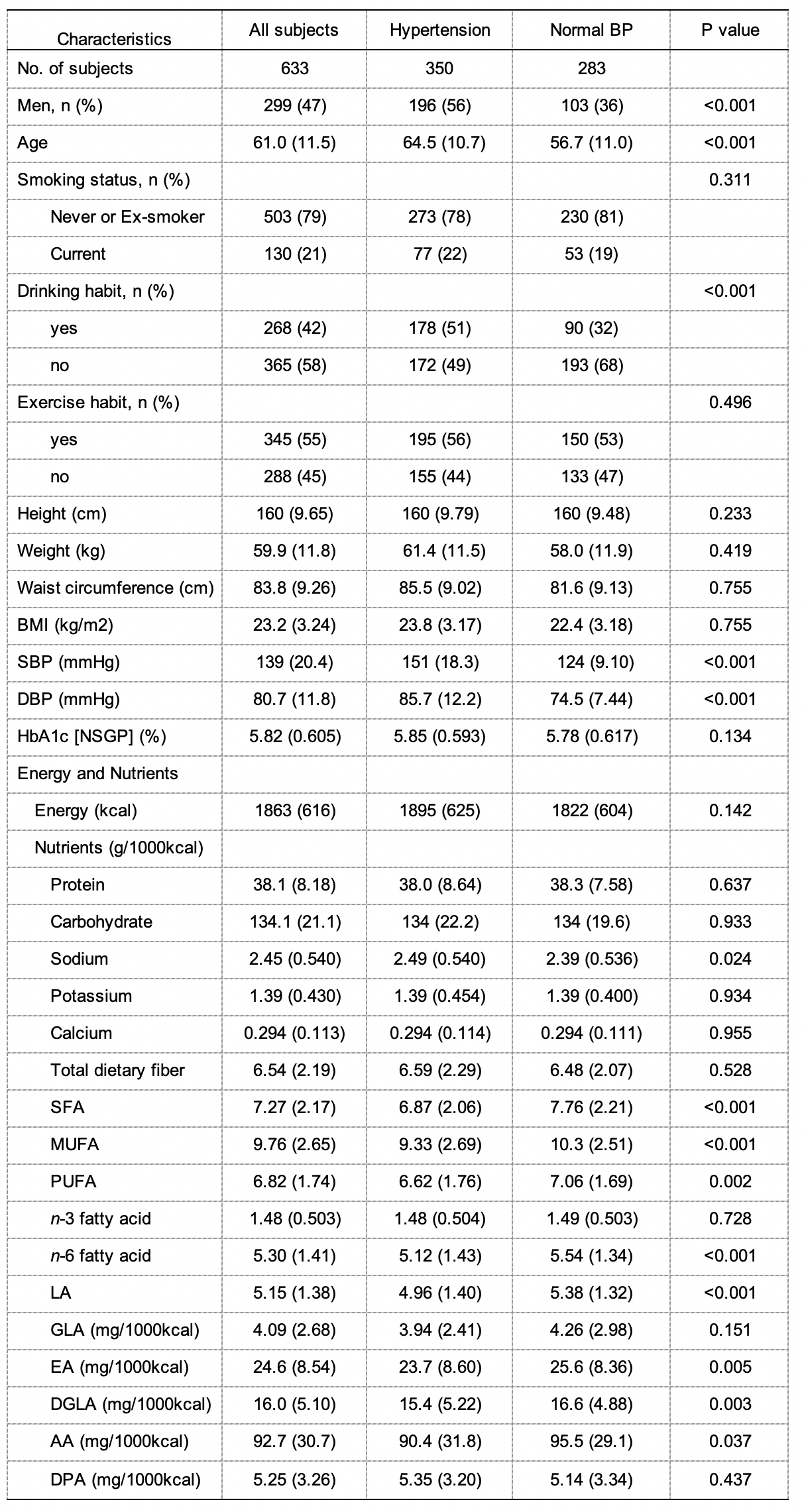Abstract:
Hypertension is an important public health problem that can lead to life-threatening cardiovascular events, including heart attack and stroke. Here, the relationship between dietary intake of n-6 fatty acids and hypertension, using blood pressure measurement and a diet history questionnaire. A Kanazawa University research team found that increased dietary intake of n-6 fatty acids positively impacted hypertension, but that this benefit was limited to individuals without impaired glucose tolerance.
Kanazawa, Japan – Hypertension is an important public health problem that can lead to life-threatening cardiovascular events, including heart attack and stroke. Many studies have attempted to understand the complex relationship between dietary factors and hypertension; none have provided a clear explanation of the interaction between hypertension and dietary intake of n-6 fatty acids (a building block of fat), until now.
In a new study published in Nutrients, a research team from Kanazawa University investigated the relationship between dietary intake of n-6 fatty acids and hypertension, using blood pressure measurement and a diet history questionnaire, and found that the relationship between dietary intake of n-6 fatty acids and hypertension was influenced by diabetes status.
“There have been conflicting reports of the relationship between dietary intake of n-6 fatty acids and risk of hypertension,” says Hiroyuki Nakamura, corresponding author on the study. “Metabolites of n-6 fatty acids can lower blood pressure in a manner influenced by blood glucose levels. Therefore, we suspected that the relationship between dietary intake of n-6 fatty acids and risk of hypertension might be affected by glucose tolerance, which is impaired in patients with diabetes.”
In the study, the researchers found that the relationship between dietary intake of n-6 fatty acids and hypertension differed according to whether subjects had diabetes; in healthy subjects, high intake of n-6 fatty acids was significantly associated with hypertension, whereas high intake of n-6 fatty acids was inversely associated with hypertension in subjects with diabetes.
“Our analyses revealed a relationship between dietary intake of n-6 fatty acids and glycated hemoglobin in the blood (our definition of diabetes), which has not been previously established,” says Haruki Nakamura, lead author on the study. “A previous meta-analysis showed that higher intake of a diet rich in linoleic acid (the main fatty acid in the n-6 fatty acids class) was significantly associated with higher risks of death from all causes, cardiovascular disease, and coronary heart disease in subjects with cardiovascular disease. Therefore, our results indicate that n-6 fatty acid intake may have no cardiovascular benefit in subjects who are at risk for cardiovascular disease or diabetes.”
In addition to the reduction of hypertension associated with increased dietary intake of n-6 fatty acids by healthy individuals, the researchers showed no benefit, and possible hypertension-related harm, from increased dietary intake of n-6 fatty acids by patients with diabetes.
Hypertension is an important risk factor for a variety of destructive cardiovascular injuries. This study showed that increased dietary intake of n-6 fatty acids could positively impact the risk of hypertension, but that this benefit is limited to individuals who do not have impaired glucose tolerance.

Table 1.
Participant characteristics in different blood pressure groups. Continuous variables are presented as mean (standard deviation). For continuous variables, we used Student's t-test to examine sex differences; for categorical variables, we used a chi-squared test to examine sex differences. Hypertensive subjects were defined as participants with SBP > 140 mmHg, DBP > 90 mmHg, or the use of antihypertensive medication. Abbreviations: AA, arachidonic acid; BMI, body mass index; BP, blood pressure; SBP, systolic blood pressure; DBP, diastolic blood pressure; DGLA, dihomo-gamma-linolenic acid; DPA, docosapentaenoic acid; EA, eicosadienoic acid; GLA, gamma-linolenic acid; HbA1c, hemoglobin A1c; LA, linoleic acid; MUFA, monounsaturated fatty acid; PUFA, polyunsaturated fatty acid; and SFA, saturated fatty acid.

Table 2.
Interaction between blood pressure and hemoglobin A1c groups by n-6 fatty acid intake. P values for interaction from two-way analysis of variance. Hypertension was defined as the use of antihypertensive medication or BP of ≥ 140/90 mmHg. A high HbA1c level was defined as an HbA1c value of ≥ 6.5%. Forty-one participants had a high HbA1c level; 12 had normal BP, and 29 had hypertension. There were 592 participants with a normal HbAc1 level; 271 had normal BP, and 321 had hypertension. Abbreviations: BP, blood pressure; HbA1c, hemoglobin A1c; LA, linoleic acid; SD, standard deviation.

Table 3.
Association between n-6 fatty acid intake and hypertension by HbA1c level. Model 1: P values from multiple logistic regression analysis after adjustments for the following independent factors: sex (male subjects or female subjects), age (continuous), BMI (continuous), frequency of exercise (yes or no), and smoking status (non-smokers, ex-smokers, or current smokers). Model 2: P values by a multiple logistic regression analysis after adjustments for all variables in Model 1, plus drinking habits and consumption of sodium; sex (male or female), age (continuous), BMI (continuous), frequency of exercise (yes or no), smoking status (non-smokers, ex-smokers, or current smokers), drinking habits (yes or no), and sodium intake (continuous). Forty-one participants had a high HbA1c level; 592 participants had a normal HbAc1 level. Hypertension subjects were defined as participants with SBP > 140 mmHg, DBP > 90 mmHg, or the use of antihypertensive medication. Abbreviations: BP, blood pressure; CI, confidence interval; HbA1c, hemoglobin A1c; LA, linoleic acid; OR, odds ratio.
Article
Relationship between Dietary n-6 Fatty Acid Intake and Hypertension: Effect of Glycated Hemoglobin Levels
Journal: Nutrients
Authors: Haruki Nakamura , Akinori Hara, Hiromasa Tsujiguchi, Thao Thi Thu Nguyen, Yasuhiro Kambayashi, Sakae Miyagi, Yohei Yamada, Keita Suzuki, Yukari Shimizu and Hiroyuki Nakamura
DOI: 10.3390/nu10121825
Funders
This study was supported by Grant-in-Aid for Scientific Research (B) by the Ministry of Education, Culture, Sport, Science and Technology (MEXT), number 15H04783.



 PAGE TOP
PAGE TOP